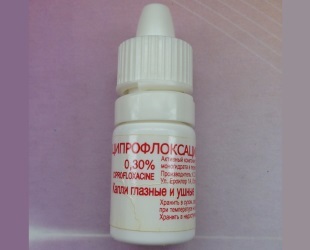
Ciprofloxacin is a preparation of an antibacterial group, belonging to the category of fluoroquinolones, effective in ophthalmic and ENT-practice.
Active active substance suppresses bacterial DNA, breaks down the synthesis of DNA, reduces the rate of bacterial growth, and also leads to their death due to changes in morphology.
Ciprilofxacin is effective in the therapy of conjunctivitis, blepharitis, their combination, corneal ulcers, eye infections, keratitis, the prevention of inflammatory infections in preparation for surgery and subsequent recovery.
- 1. Instructions for use
- 2. Side effects of
- 3. Conditions and shelf life
- 4. Price
- 5. Analogues
- 6. Reviews
- 7. Video
Instruction for use
For uncomplicated eye infections, the drugBury with a periodicity of 4 hours. Dosage of 1-2 drops.
In the presence of complications or severe course, the interval between injections of the drug is reduced to an hour until signs of improvement appear.
The pipette should not touch the eye and mucous membranes during instillation. Most often, the drug is prescribed for up to 3 weeks.
Form release, composition
| Form | Clear solution with a light yellowish tinge. The preparation is packaged in bottles of IV-PE droppers with a volume of 3 or 5 ml. |
| Active substance | Ciprofloxacin hydrochloride( concentration 0,3%) |
| Additional substances | Disodium salt EDTA, beckons either mannitol, anhydrous or trihydrate sodium acetate, acetic acid, benzalkonium chloride, water. |
Interaction with other drugs

Joint reception with didanosine, as well as with antacids, drugs, which contain ions of aluminum, magnesium, iron, reduces the absorption of ciprofloxacin.
In combination with other antimicrobial agents, its effect is enhanced. Increases the toxic effect on the kidneys of cyclosporine. NSAIDs( other than aspirin) increase the likelihood of seizures. Strengthens the effect of indirect anticoagulants.
Side effects of
Taking the drug inside is not dangerous because the quantities of the drug in one bottle are not enough to cause intoxication. The drug is not characterized by pronounced, as well as serious side effects.
Usually, its intolerance manifests itself in the form of local allergic reactions( usually dermal).The gastrointestinal tract can react with the appearance of nausea. Some patients report a decrease in the focus of vision immediately after application.
No overdose has been reported.

After instillation, the conjunctival sac, tearing, photophobia, burning and stinging in the eyes may blush. If the drug is used in a diagnosed corneal ulcer, white deposits can be seen on it.
In case of long-term preservation of redness or its amplification, it is advisable to stop ciprofloxacin therapy and choose another drug.
Extremely rare side effect - the appearance of inflammation of the cornea, its turbidity, the germination of blood vessels.
Increased caution should be observed for violations of the blood circulation of the brain, damage to the blood vessels of the brain.
During the treatment with ciprofloxacin, the use of contact lenses is not recommended, except for hard lenses. However, a few minutes before instillation, they should be removed, re-donning is recommended not earlier than 20 minutes after the use of the drug.
Special attention should be paid to the use of ciprofloxacin by people whose activities are related to the work with precise equipment and measuring instruments, as well as the management of cars. Due to a decrease in visual acuity, increased caution is necessary.

Contraindications
- is less than 18 years old;
- during the entire breastfeeding period of the child;
- in the case when viral keratitis is diagnosed;
- if previously noted intolerance or hypersensitivity to substances in the composition.
In pregnancy,
Ciprofloxation during pregnancy is possible only if a positive effect is expected that exceeds the probable risks.
To avoid the appearance of visual impairment, you should read the following material:
- How to properly instill drops?
- Prevention of visual impairment
- What if I have a corner of my eye?
. Conditions and storage times.
. Avoid exposure to light. It is stored no more than 3 years at a temperature of up to 25 degrees Celsius, and if an open vial, it will become unusable after 4 weeks.
Price

Average cost of the drug in Russian pharmacies
Russian pharmacy chains offer to buy Ciprofloxacin from 16 rubles( Russian production).
Preparations of foreign pharmaceutical companies are offered at a price of 130 rubles per bottle.
Average cost of the drug in pharmacies of Ukraine
In the pharmacies of Ukraine it is offered to buy Ciprofloxacin at a price of about 18-20 hryvnia per 1 packing.
Analogues
Ciprofloxacin has many analogues, which contain the same active substance. Among the most popular are Conjunctin, Tsiprolet, Tsipromed, Levofloxacin, Ophthalmol. In addition, the analogues are Ciprdox, Oftdek, Lofoks, Oftakviks, Vigamoks, L-Optik Rompharm and a number of others.
Reviews
The vast majority of reviews indicate the high effectiveness of the drug and its relevance. There are, of course, negative, associated mainly with the manifestation of side effects and inconvenience of therapy for people who need stable clear vision, but they are very rare.
Video
How correctly to instill eye drops?
